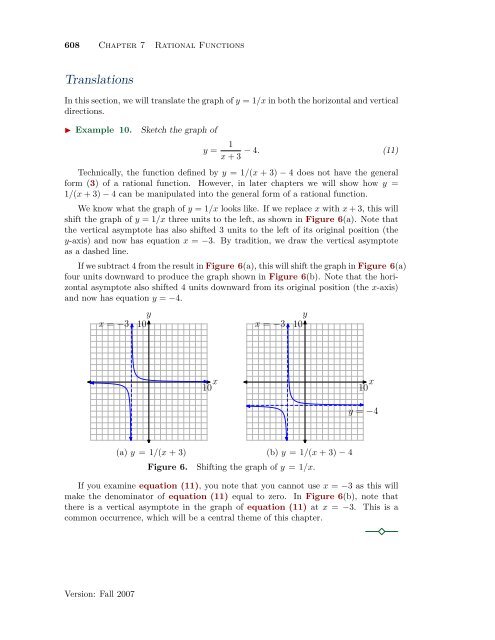Chapter 7 Rational Functions - College of the Redwoods
Chapter 7 Rational Functions - College of the Redwoods
Chapter 7 Rational Functions - College of the Redwoods
You also want an ePaper? Increase the reach of your titles
YUMPU automatically turns print PDFs into web optimized ePapers that Google loves.
608 <strong>Chapter</strong> 7 <strong>Rational</strong> <strong>Functions</strong><br />
Translations<br />
In this section, we will translate <strong>the</strong> graph <strong>of</strong> y = 1/x in both <strong>the</strong> horizontal and vertical<br />
directions.<br />
◮ Example 10.<br />
Sketch <strong>the</strong> graph <strong>of</strong><br />
y = 1 − 4. (11)<br />
x + 3<br />
Technically, <strong>the</strong> function defined by y = 1/(x + 3) − 4 does not have <strong>the</strong> general<br />
form (3) <strong>of</strong> a rational function. However, in later chapters we will show how y =<br />
1/(x + 3) − 4 can be manipulated into <strong>the</strong> general form <strong>of</strong> a rational function.<br />
We know what <strong>the</strong> graph <strong>of</strong> y = 1/x looks like. If we replace x with x + 3, this will<br />
shift <strong>the</strong> graph <strong>of</strong> y = 1/x three units to <strong>the</strong> left, as shown in Figure 6(a). Note that<br />
<strong>the</strong> vertical asymptote has also shifted 3 units to <strong>the</strong> left <strong>of</strong> its original position (<strong>the</strong><br />
y-axis) and now has equation x = −3. By tradition, we draw <strong>the</strong> vertical asymptote<br />
as a dashed line.<br />
If we subtract 4 from <strong>the</strong> result in Figure 6(a), this will shift <strong>the</strong> graph in Figure 6(a)<br />
four units downward to produce <strong>the</strong> graph shown in Figure 6(b). Note that <strong>the</strong> horizontal<br />
asymptote also shifted 4 units downward from its original position (<strong>the</strong> x-axis)<br />
and now has equation y = −4.<br />
x = −3<br />
y<br />
10<br />
x = −3<br />
y<br />
10<br />
x<br />
10<br />
x<br />
10<br />
y = −4<br />
(a) y = 1/(x + 3) (b) y = 1/(x + 3) − 4<br />
Figure 6. Shifting <strong>the</strong> graph <strong>of</strong> y = 1/x.<br />
If you examine equation (11), you note that you cannot use x = −3 as this will<br />
make <strong>the</strong> denominator <strong>of</strong> equation (11) equal to zero. In Figure 6(b), note that<br />
<strong>the</strong>re is a vertical asymptote in <strong>the</strong> graph <strong>of</strong> equation (11) at x = −3. This is a<br />
common occurrence, which will be a central <strong>the</strong>me <strong>of</strong> this chapter.<br />
Version: Fall 2007

















